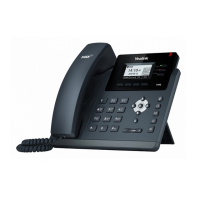Administrator’s Guide for SIP-T2 Series/T4 Series/T5 Series IP Phones
216
It enables or disables the IP phone to send all SIP requests to the outbound proxy
server mandatorily in a dialog.
Note: It works only if “account.X.outbound_proxy_enable” is set to 1 (Enabled).
0-Disabled, only the new SIP request messages from the IP phone will be sent to the
outbound proxy server in a dialog.
1-Enabled, all the SIP request messages from the IP phone will be sent to the
outbound proxy server in a dialog.
Features->General Information->Use Outbound Proxy In Dialog
Server Redundancy
Server redundancy is often required in VoIP deployments to ensure continuity of phone service, for
example, take the call server offline for maintenance, the server fails, or the connection between the IP
phone and the server fails.
Two types of redundancy are possible. In some cases, a combination of the two may be deployed:
Failover: In this mode, the full phone system functionality is preserved by having a second
equivalent capability call server take over from the one that has gone down/off-line. This mode of
operation should be done using the DNS mechanism from the primary to the secondary server.
Therefore, if you want to use this mode, the server must be configured with a domain name.
Fallback: In this mode, a second less featured call server with SIP capability takes over call control to
provide basic calling capability, but without some advanced features (for example, shared line and
MWI) offered by the working server. IP phones support configuration of two servers per SIP
registration for fallback purpose.
For concurrent registration mode, it has certain limitation when using some advanced features, and for
successive registration mode, the phone service may have a brief interrupt while the server fails. So we
recommend you to use the failover mode for server redundancy because this mode can ensure the
continuity of the phone service and you can use all the call features while the server fails.
Phone Configuration for Redundancy Implementation
To assist in explaining the redundancy behavior, an illustrative example of how an IP phone may be
configured is shown as below. In the example, server redundancy for fallback and failover purposes is
deployed. Two separate servers (a working server and a fallback server) are configured for per line
registration.

